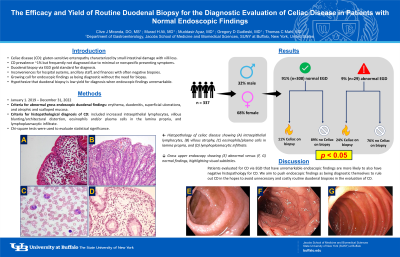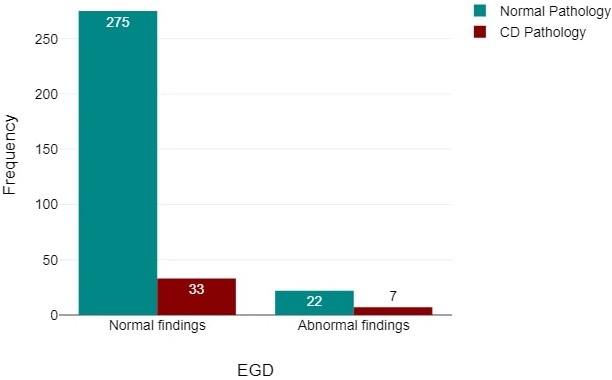Tuesday Poster Session
Category: Practice Management
P4060 - The Efficacy and Yield of Routine Duodenal Biopsy for the Diagnostic Evaluation of Celiac Disease in Patients with Normal Endoscopic Findings
Tuesday, October 24, 2023
10:30 AM - 4:00 PM PT
Location: Exhibit Hall

Has Audio

Clive J. Miranda, DO, MS
University at Buffalo
Buffalo, NY
Presenting Author(s)
Clive J. Miranda, DO, MS, Murad H. Ali, MD, Muddasir Ayaz, MD, Gregory D. Gudleski, PhD, Thomas C. Mahl, MD
University at Buffalo, Buffalo, NY
Introduction: Celiac disease (CD) is a gluten-sensitive enteropathy characterized by small intestinal damage with loss of villi, leading to the classic symptoms of malabsorption, diarrhea, and failure to thrive. Though the prevalence of CD may be as high as 1%, it is frequently not diagnosed due to minimal or nonspecific presenting symptoms. To date, a duodenal biopsy via esophagogastroduodenoscopy (EGD) is the gold standard for the diagnosis of CD. However, considering the inconvenience and cost associated with biopsies that often yield negative results, there is a growing call for endoscopic findings as being diagnostic without the need for biopsy. In this study, we hypothesize that it is low yield to biopsy the duodenum to diagnose CD when endoscopic findings appear unremarkable.
Methods: A retrospective chart review of our institution’s records was conducted from 2019-2022. Patients undergoing EGD with biopsy for evaluation of CD were identified. Demographic and laboratory data were collected. Abnormal gross endoscopic duodenal findings included erythema, duodenitis, superficial ulcerations, and atrophic and scalloped mucosa. Criteria for histopathological diagnosis of CD included increased intraepithelial lymphocytes, villous blunting/architectural distortion, eosinophils and/or plasma cells in the lamina propria, and lymphoplasmacytic infiltrate. Chi-square tests were used to evaluate statistical significance.
Results: A total of 337 patients (n=337) undergoing EGD with biopsy for the diagnostic evaluation of CD were identified. 109 patients (32%) were male and 228 patients (68%) were female. Of these, 308 patients (91%) had normal EGD findings whilst 29 patients (9%) had abnormal EGD findings. There was a statistical significance between gender and endoscopic findings with 18 (17%) male patients and 11 (5%) female patients having an abnormal EGD (p < 0.001). 33 (11%) of the 308 patients with normal EGDs yielded positive CD findings on pathology. 7 (24%) of the 29 patients with abnormal EGDs yielded positive CD findings on pathology. This is indicated statistically significant relationship between findings on gross endoscopy and histopathological findings of CD (p < 0.05).
Discussion: Patients evaluated for CD via EGD that have unremarkable endoscopic findings are more likely to also have negative histopathology for CD. We aim to push endoscopic findings as being diagnostic themselves to rule out CD in the hopes to avoid unnecessary and costly routine duodenal biopsies in the evaluation of CD.

Disclosures:
Clive J. Miranda, DO, MS, Murad H. Ali, MD, Muddasir Ayaz, MD, Gregory D. Gudleski, PhD, Thomas C. Mahl, MD. P4060 - The Efficacy and Yield of Routine Duodenal Biopsy for the Diagnostic Evaluation of Celiac Disease in Patients with Normal Endoscopic Findings, ACG 2023 Annual Scientific Meeting Abstracts. Vancouver, BC, Canada: American College of Gastroenterology.
University at Buffalo, Buffalo, NY
Introduction: Celiac disease (CD) is a gluten-sensitive enteropathy characterized by small intestinal damage with loss of villi, leading to the classic symptoms of malabsorption, diarrhea, and failure to thrive. Though the prevalence of CD may be as high as 1%, it is frequently not diagnosed due to minimal or nonspecific presenting symptoms. To date, a duodenal biopsy via esophagogastroduodenoscopy (EGD) is the gold standard for the diagnosis of CD. However, considering the inconvenience and cost associated with biopsies that often yield negative results, there is a growing call for endoscopic findings as being diagnostic without the need for biopsy. In this study, we hypothesize that it is low yield to biopsy the duodenum to diagnose CD when endoscopic findings appear unremarkable.
Methods: A retrospective chart review of our institution’s records was conducted from 2019-2022. Patients undergoing EGD with biopsy for evaluation of CD were identified. Demographic and laboratory data were collected. Abnormal gross endoscopic duodenal findings included erythema, duodenitis, superficial ulcerations, and atrophic and scalloped mucosa. Criteria for histopathological diagnosis of CD included increased intraepithelial lymphocytes, villous blunting/architectural distortion, eosinophils and/or plasma cells in the lamina propria, and lymphoplasmacytic infiltrate. Chi-square tests were used to evaluate statistical significance.
Results: A total of 337 patients (n=337) undergoing EGD with biopsy for the diagnostic evaluation of CD were identified. 109 patients (32%) were male and 228 patients (68%) were female. Of these, 308 patients (91%) had normal EGD findings whilst 29 patients (9%) had abnormal EGD findings. There was a statistical significance between gender and endoscopic findings with 18 (17%) male patients and 11 (5%) female patients having an abnormal EGD (p < 0.001). 33 (11%) of the 308 patients with normal EGDs yielded positive CD findings on pathology. 7 (24%) of the 29 patients with abnormal EGDs yielded positive CD findings on pathology. This is indicated statistically significant relationship between findings on gross endoscopy and histopathological findings of CD (p < 0.05).
Discussion: Patients evaluated for CD via EGD that have unremarkable endoscopic findings are more likely to also have negative histopathology for CD. We aim to push endoscopic findings as being diagnostic themselves to rule out CD in the hopes to avoid unnecessary and costly routine duodenal biopsies in the evaluation of CD.

Figure: Rates of normal versus abnormal EGD (blue) and abnormal histopathologic (red) findings in the diagnostic evaluation of celiac disease in our patient cohort.
Disclosures:
Clive Miranda indicated no relevant financial relationships.
Murad Ali indicated no relevant financial relationships.
Muddasir Ayaz indicated no relevant financial relationships.
Gregory Gudleski indicated no relevant financial relationships.
Thomas Mahl indicated no relevant financial relationships.
Clive J. Miranda, DO, MS, Murad H. Ali, MD, Muddasir Ayaz, MD, Gregory D. Gudleski, PhD, Thomas C. Mahl, MD. P4060 - The Efficacy and Yield of Routine Duodenal Biopsy for the Diagnostic Evaluation of Celiac Disease in Patients with Normal Endoscopic Findings, ACG 2023 Annual Scientific Meeting Abstracts. Vancouver, BC, Canada: American College of Gastroenterology.
